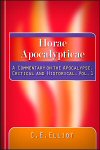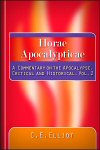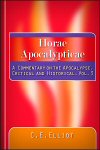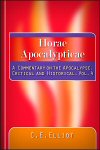Horæ Apocalypticæ: A Commentary on the Apocalypse, Critical and Historical (4 vols.)
Digital Logos Edition
Overview
The book of Revelation is arguably the most mysterious and controversial book of the Bible, and Horæ Apocalypticæ seeks to clear the confusion associated with this book and interpret it in context. First published in 1844, it took E. B. Elliott seven years to complete the first edition. Considered an immediate scholarly standard, Horæ Apocalypticæ: A Commentary on the Apocalypse, Critical and Historical focuses on the critical historical context of both the time and the writing itself, as well as the supernatural inspiration of the text.
Defending Revelation from a purely rationalist view common at the time, Elliott believed that a combination of broad historical context and specific spiritual considerations were essential to reading not just Revelation, but all of Scripture. Boasting over 2,500 pages for all four volumes, Elliott provides a systematic view of the Apocalypse. He examines various symbols and prophecies, points out parallels between Revelation and historical events and people, and finally offers a concluding application. Elliott also includes an appendix and a list of plates.
With Logos Bible Software, these volumes are enhanced with cutting-edge research tools. Scripture citations appear on mouseover in your preferred English translation. Important terms link to dictionaries, encyclopedias, and a wealth of other resources in your digital library. Powerful topical searches help you find exactly what you’re looking for. With Logos Bible Software, the most efficient and comprehensive research tools are in one place, so you get the most out of your study.
Reviews
1 rating
Key Features
- Considered one of the most influential and thorough works on the book of Revelation
- Contains a massive study on the book of Revelation
- Includes an extensive appendix for guided study
Product Details
- Title: Horæ Apocalypticæ: A Commentary on the Apocalypse, Critical and Historical
- Author: E. B. Elliott
- Volumes: 4
- Pages: 2,793
Individual Titles
- Horæ Apocalypticæ: A Commentary on the Apocalypse, Critical and Historical, vol. 1, by E. B. Elliott
- Horæ Apocalypticæ: A Commentary on the Apocalypse, Critical and Historical, vol. 2, by E. B. Elliott
- Horæ Apocalypticæ: A Commentary on the Apocalypse, Critical and Historical, vol. 3, by E. B. Elliott
- Horæ Apocalypticæ: A Commentary on the Apocalypse, Critical and Historical, vol. 4, by E. B. Elliott

This is arguably one of the most influential and thorough works on the book of Revelation. First published in 1844, it took Elliott seven years to complete the first edition. Considered an immediate scholarly standard, Horæ Apocalypticæ: A Commentary on the Apocalypse, Critical and Historical, vol. 1 focuses on critical historical context of both the time and the writing itself, as well as the supernatural inspiration of the text. This first volume includes an introduction to Elliott’s line of thinking, St. John in exile, general views of the Seven Seals, and explanation and application of certain symbols.

This second volume continues Elliott’s extensive study on the book of Revelation. Elliott covers an overview of Western Christendom, principles of the Reformation appearing in the ministry of Christ, the two witnesses, an appendix, and a list of illustrative plates.

The third volume of Elliott’s work contains examinations of various symbols and prophecies, such as the sun-clad woman, the image of the beast, and the mark of the beast. Elliott also points out parallels between Revelation and historical events and people.

Elliott concludes his massive study with a discussion of Daniel’s prophecies, as well as other Old Testament prophets. He also addresses the Apocalyptic philosophy of Christendom over the years and a concluding application. Elliott also includes an appendix and a list of plates.
This title is included in the following collections
You can save when you purchase this product as part of a collection.
Classic Commentaries and Studi...
$69.99$49.992025 Anglican Portfolio
$4,749.99$3,562.49Complete Classic Commentary Co...
$17,553.16$3,699.992025 Collector's Edition Libra...
$10,999.99$8,249.99
- $11,399.99
- $11,399.99
- $23,999.99$17,999.99
- $21,749.99
- $24,999.99
About Edward Bishop Elliott
Edward Bishop Elliott (1793–1875) was born in England. He was an Anglican minister who also wrote extensively on prophecy and the book of Revelation. Educated at Cambridge, he was a premillennial evangelical. Elliott is well-known for Horæ Apocalypticæ: A Commentary on the Apocalypse, Critical and Historical, or Hours of the Apocalypse.
Reviews
1 rating

David Anfinrud
3/20/2023
I like reading the older works. They give more details than you find in many works today. And often more trustworthy.